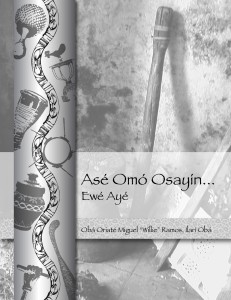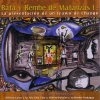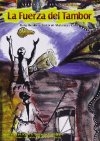 by Obá Oriaté Miguel “Willie” Ramos, Ilarí Obá.
by Obá Oriaté Miguel “Willie” Ramos, Ilarí Obá.
As a young Olorisha in New York, I became aware of what I considered an urgent need to disseminate information to other Olorishas about our religious practices. By my sixteenth birthday, I had published the first edition of this book, 100 books, meant to circulate solely amongst my friends and the members of my ilé. Looking back on that book today, in many respects I feel embarrassed by it as the spelling errors and typos were so numerous that it still upsets me. In fact, I am often angered whenever I see the pirate copies of that edition that are still offered for sale, primarily in New York.
Dominated by religious fervor and an idealist frame of mind, I was very naive, gullible and inexperienced in the affairs of the “real” world and I paid the price. The printer, who according to our agreement was supposed to have edited the book, never did so. As a result, the book was printed with all the grammatical mistakes, spelling errors, and even the crossed-out words—typos—that the printer was supposed to have edited but never did. When I saw the finished product, and the printer’s despotism-who after all was dealing with a kid- I was upset but naive, and the printer refused to repair the damage. I lost half my money which I gave as an initial deposit but I took the books as they were. The printer lost his work that I refused to pay for-I may have been naive but not stupid! Still, since the edition was for a small group of people, I did not make much of it and distributed as it was, with all the errors. Was that a mistake!
In spite of all these flaws, though, in a matter of months, the intellectual pirates somehow got a hold of one of the books and published and republished it over and over again, with all its errors, and most detrimental of all, without my consent! It was stolen! The lawyers I consulted suggested that it would be a waste of time to pursue any legal course of action because it was such a minor case-“small fry”- that it was not worth the time and effort. Thousands of pirate copies of the book hit the market and were on sale at botanicas all over the city. Surprisingly, in spite of all its errors, the book was very successful. For some reason, probably dictated by the little literature available during that early period of Lukumí religion in the U.S., the book was always well received. To this day, I come across people who tell me that thanks to this book, they learned to chant Osayín— chants are the book’s major emphasis— or that they use the book to consult some of the bead patterns I describe for some of the orishas. The fact that this book was influential to scores of Olorishas in many, many ways is my major reward. Modupé ó!
Since the first edition in 1975, the book has been reprinted by me several other times in this edited version advertised here—also being pirated by deceitful and petty thieves (of which there are many others today) who prey on intellectual property for their own financial benefit because they lack the intellect to do it any other way. The book is in Spanish, however I am currently considering a revised, English version. While I am aware that this book contains a number of flaws and errors, especially in terms of the Yoruba grammar and orthography, I cannot help but feel that it continues to perform the task I originally had in mind when I first published it: disseminate information. The book is a valuable stepping stone for the young Olorisha and for the aleyo as well in that it lays foundations for future edification.
Desde que fui iniciado en la religión en la ciudad de Nueva York, me preocupé por lo que consideré una urgente necesidad de diseminar información sobre la religión lukumí a la creciente comunidad religiosa en Estados Unidos. Con a penas unos dieciséis años de edad, publiqué la primera edición de este libro, unos 100 tomos, los cuales pensé distribuir entre algunas amistades y los miembros de mi Ilé Osha. Actualmente, al revisar el manuscrito y el ejemplar de aquel primer libro, me siento un tanto abochornado, ya que los errores ortográficos y gramaticales fueron muchos y el libro se imprimió sin poderle hacer las debidas correcciones. Más me enfado cuando veo las copias piratas de aquella edición, que aun siguen vendiendo—especialmente en Nueva York—los ladrones y rateros baratos que se lucran del trabajo y esfuerzo de otros sin el más mínimo remordimiento.
Impulsado por el fervor religioso y una mentalidad idealista e ingenua, fui victima de mi propia falta de malicia e inexperiencia tocante a los asuntos del mundo “real”, y por lo cual pagué costosamente. El impresor, quien según nuestro acuerdo editaría el libro y corregiría los errores, nunca lo hizo. Resultó que el libro fue impreso con todos los errores y hasta las tachas y borrones que el editor se suponía que corrigiera más nunca hizo. Cuando obtuve el producto final, y tropecé con la defensa despótica del impresor, quien después de todo estaba tratando con un chiquillo inmaduro, este rehúso a enmendar su error. Perdí la mitad del dinero que me había pedido por el trabajo, pero me entregó los libros tal y como estaban, sin corregirlos. El también perdió pues nunca cobró la suma completa que había pedido por hacer el trabajo—yo sería ingenuo, pero no estúpido. Arriba de que había hecho el trabajo mal, sería yo demasiado tonto si le pagaba el balance. No obstante, como la idea inicial era de repartir esta edición a mis amistades y familia de Osha, no me preocupé tanto y los distribuí tal y como estaban, con un sin número monstruoso de errores. ¡Que metida de patas!
A pesar de sus faltas, en cuestión de meses, los piratas intelectuales lograron conseguir una copia del libro y lo imprimieron y repartieron por toda la ciudad de Nueva York, nuevamente sin corregir ningún error, y más indignante aún, sin mi consentimiento. Nuevamente caí de victima. Consulté algunos abogados, pero todos coincidieron en una cosa—perseguirles sería un proceso difícil y muy costoso para un asunto tan pequeño, pues perdería tiempo y dinero sin garantía alguna.
Se repartieron miles de ejemplares piratas a través de las botánicas de la ciudad. Para mi gran sorpresa, a pesar de todas sus faltas, el libro gozó de un gran éxito. Por razones inexplicables, posiblemente impulsado por la escasez de materiales sobre la religión existentes en la era, el libro siempre fue muy bien recibido. Hasta en la actualidad, constantemente me encuentro con personas que me confiesan que aprendieron los súyeres de Osayín y los orishas gracias a este libro o que consultan el libro cuando desean conocer los colores rituales para el ensarte de los collares de sus orishas. El mero hecho de que este libro haya influenciado la vida de tantos olorishas quizás sea mi mayor recompensa. ¡Modupé ó!
Desde aquella monstruosa edición de 1975, la edición revisada de este libro se ha impreso tres veces más. Lamentablemente, los piratas aun siguen al acecho. Carecen de la intelectualidad para producir trabajos de valor para la comunidad religiosa, pero más aún, carecen de el más básico sentido de la ética, pero les sobra inmoralidad y vileza. Deposito esta injusticia en las manos de Ogún, Shangó y Olodumare.
Aunque estoy muy consciente de que la edición revisada también contiene algunos errores, y que mi propia perspectiva ha evolucionado con el andar de los años y la experiencia adquirida, no puedo dejar de sentir que este libro logró cumplir con los deseos de aquel joven ingenuo de dieciséis años: diseminar información. Considero que el libro es una herramienta muy valiosa para el iyawó y el olorisha joven que están dando sus primeros pasos dentro de la religión lukumí, al igual que lo es para el aborisha o aleyó que está tratando de lograr una mejor comprensión sobre la religión en la cual se está introduciendo.
Traduzido perto Ricardo Ferreira do Amaral, advogado, artista plástico e filho de Airá.
Desde que fui iniciado na religião na cidade de Nova Iorque, preocupei-me pelo que considerei uma urgente necessidade de disseminar informação sobre a religião lukimi à crescente comunidade religiosa nos Estados Unidos. Com apenas dezesseis anos de idade, publiquei a primeira edição deste livro, uns 100 tomos, que pensei distribuir entre algumas amizades e os membros do meu Ilé Osha. Atualmente, revisando o manuscrito e o exemplar daquele primeiro livro, me sinto um tanto envergonhado, pois os erros ortográficos e gramaticais foram muitos e o livro foi impresso sem que pudessem ser feitas as devidas correções. Mais me zango ainda, quando vejo as cópias piratas daquela edição, que ainda seguem vendendo – especialmente em Nova Iorque – os ladrões e gatunos baratos que lucram com o trabalho e esforço dos outros sem o mínimo remorso.
Impulsionado pelo fervor religioso e uma mentalidade idealista e ingênua, fui vítima da minha própria falta de malícia e pela inexperiência tocante aos assuntos do mundo “real”, pelo que paguei com muito custo. O impressor, que segundo nosso acordo editaria o livro e corrigiria os erros, nunca cumpriu o combinado. O resultado foi que o livro foi impresso com todos os erros e até com os riscos e borrões que o editor, supunha-se que os corrigisse mas nunca o fez.
Quando obtive o produto final e tropecei com a defesa despótica do impressor, que ao final das contas estava tratando com um pirralho imaturo, aquele se recusou a sanar seu erro. Perdi a metade do dinheiro que ele havia pedido pelo trabalho, porém, me entregou os livros tal qual estavam, sem nenhuma correção. Ele também perdeu, pois nunca cobrou a soma completa que tinha pedido para fazer o trabalho – eu era ingênuo, mas não estúpido. Ainda por cima de ter feito mal o trabalho, eu seria demasiado bobo se lhe pagasse o saldo faltante. No entanto, como a idéia inicial era a de repartir aquela edição às minhas amizades e família de Osha, não me preocupei tanto assim e distribui os livros tal qual estavam, com um sem número monstruoso de erros. Que mancada!
Apesar das falhas, em questão de meses, os piratas intelectuais conseguiram uma cópia do livro e o imprimiram e repartiram por toda a cidade de Nova Iorque, novamente sem corrigir nenhum erro e o mais indignativo: sem o meu consentimento. Novamente fui vítima. Consultei alguns advogados, mas todos coincidiram numa coisa: perseguí-los seria um processo difícil e por demais oneroso para um assunto tão pequeno, pois perderia tempo e dinheiro sem garantia alguma.
Foram repartidos milhares de exemplares piratas através das botânicas (lojas especializadas em artigos religiosos) da cidade. Para grande surpresa minha, apesar de todas as falhas, o livro gozou de um grande êxito. Por razões inexplicáveis – provavelmente impulsionado pela escassez de material sobre a religião naquela época- o livro sempre foi muito bem recebido. Até na atualidade, constantemente encontro com pessoas que me confessam terem aprendido os súyeres de Osayín e os orixás, graças a esse livro ou que consultam o livro quando desejam conhecer as cores rituais para confeccionar os colares de seus orixás. O mero fato de este livro ter influenciado a vida de tantos olorixás, quiçá seja a minha maior recompensa. Modupé ó!
Desde aquela monstruosa edição de 1975, a edição revisada deste livro tem sido impressa por mais três vezes. Lamentavelmente, os piratas continuam à espreita. Carecem de intelectualidade pra produzir trabalhos de valor para a comunidade religiosa, porém ainda mais, carecem do mais básico sentido de ética, sobrando-lhes imoralidade e vileza. Deposito esta injustiça nas mãos de Ogum, Xangô e Olodumarê.
Ainda que esteja muito consciente de a edição revisada também conter alguns erros, e de minha perspectiva ter evoluído através dos anos e da experiência adquirida, não posso deixar de sentir que este livro conseguiu cumprir com os desejos daquele jovem ingênuo de dezesseis anos: disseminar informação. Considero que o livro é uma ferramenta muito valiosa para o iyawô e o olorixá jovem que estejam dando seus primeiros passos dentro da religião lukumi, da mesma maneira que para o aborixá ou aleyô que está tratando de obter uma melhor compreensão sobre a religião na que está se introduzindo.
Asé Omó Osayín. . . Ewé Ayé
$24.99 +8.50 Priority Mail S&H






